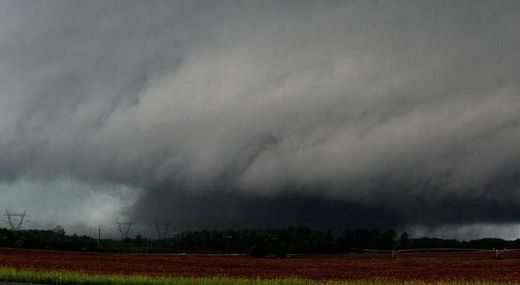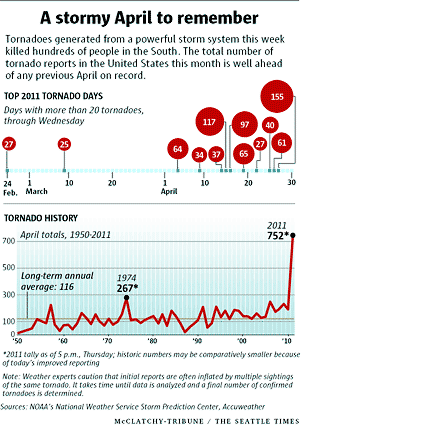
"The air was palpable with the potential," said DeBlock, the warning-coordinator meteorologist at the National Weather Service office in Birmingham.
By the time the storms ended early Thursday, the destruction awed even veteran storm observers - 148 reported tornadoes, winds perhaps exceeding 300 mph, and at least 297 deaths from Alabama to Virginia.
Overall, it was a dramatic climax to one of the wildest months in U.S. weather history. The atmosphere has been in a state of riot.
At least 750 tornado sightings have been reported this month, according to the government's Storm Prediction Center. Those figures include some double-counting, and the final total should be around 600. Until now, no April on record had surpassed the 267 tornadoes recorded in 1974.
What's going on?
Every spring, the atmosphere over the United States becomes a battleground between winter cold retreating into Canada and summer heat invading from the Gulf of Mexico.
That's a big reason why the United States is far and away the world capital for tornadoes, the most violent storms on Earth.
Thunderstorms form at the collisions of cold and warm air, as moisture-laden warm air is forced to rise and water vapor condenses into rain. Under the right circumstances, such a storm can mutate into a "supercell" that spawns tornadoes.
Those storms have been especially potent this year, in part because of the Gulf, where surface temperatures have been significantly higher than normal, said Henry Margusity, a meteorologist with AccuWeather in State College, Pa.
"There's a bathtub there just pumping warm air into the Mississippi Valley," he said. The warmer the air, the more moisture it can hold.
"That warm air is what feeds that supercell beast," DeBlock said.
The moisture has had an extra lift from ultra-energized, jet-stream winds, said Russell Schneider, chief of the government's Storm Prediction Center. Those are the upper-air westerlies that circle the planet, moving weather systems and detonating storms.
As those winds blow over a storm, they force the air underneath to rise violently.
Margusity said the strength of the jet-stream winds can be traced to the tropical Pacific. During winter, surface temperatures over tens of millions of miles of the Pacific Ocean were about as low as they get, a phenomenon known as La Niña.
In the Pacific Northwest, the pattern typically means higher-than-average snowfall and colder temperatures. Farther south and east, though, jet streams form over boundaries of warm and cold air, and unusually cool or warm waters in the Pacific have a powerful impact on those contrasts, and thus the speed of winds.
On Wednesday, jet-stream winds over Alabama were estimated at 150 mph. Meanwhile, near the surface in the tornado zone, winds were blowing strongly from the south.
The conflicting winds at different levels of the atmosphere helped give the storms the spins that turned them deadly.
"Yesterday was remarkable for the environmental conditions," Schneider said.
Recent research shows a possible link between La Niña and exceptionally strong tornado outbreaks, said Harold Brooks, a researcher at the National Severe Storms Laboratory in Norman, Okla.
La Niña coincided with the April 1974 severe-storm season. That year, an April outbreak was blamed for 310 deaths, the most in the reporting era dating to 1950.
It may be days before a final death toll and tornado count are available for the Wednesday/Thursday storms.
DeBlock said investigators were tracking down the preliminary reports. It is tough to compare recent tornado data with those of past decades, because radar detection today is superior and more people are living in places where few lived before.
His investigators are trying to determine the wind strength through the damage evidence, but Schneider said some of the tornadoes likely reached levels 4 and 5 - winds of 208 to 318 mph - on the Enhanced Fujita Scale.
Given the warnings, Margusity said, it was puzzling that so many people were killed. "You have more communication devices than ever before, and people are dying," he said.
DeBlock said the fatalities evidently included some people who had taken precautions and sought shelter. But a 300-mph wind is going to overmatch almost anything in its path.
"There aren't many structures that are going to withstand the impact of that beast," he said. "A safe place reduces risk; it doesn't eliminate it."




After reading this article I'm wondering if there is a correlation to the super-cells, with the cutting off of the warm loop of the Gulf Stream that enters the Gulf of Mexico/Caribbean as well as the increasing EM charging and discharging activity? Before the BP Gulf Horizon catastrophe, the warm loop in the Gulf Stream would enter this area and transport a large amount of thermal ocean energy up to more northern latitudes. If this particular loop and portion of the Gulf stream has been cut of, or receded, then we could expect that this year there would be a larger (than statistically average) build up of heat in the ocean in the gulf area, due to the lack of that heat being transported elsewhere by the loop current. This would go some way as to explaining the additional heat and humidity in the atmosphere in the southern states, which then feeds more of these super-cell storms. If the theoretical idea is correct, then unfortunately I would expect that far from being over and the last of these catastrophic super-cell type storms, this would be just one of many this year, and it would also not bode well for the start of the hurricane season.